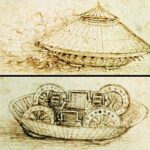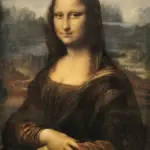
Leonardo da Vinci greatest inventions have fascinated people for centuries. He combined art, science, and mechanical skill in ways that changed history.
You might find it challenging to keep track of the numerous amazing creations he imagined and designed. This article will make it easy for you.
Get ready to discover twenty of his most important and creative inventions. They are explained in simple terms for anyone curious about da Vinci’s genius.
From flying machines to early designs for tanks and bridges, da Vinci’s ideas show how far ahead of his time he was.
This collection provides readers with a clear view of his imaginative work and unique thinking, which have inspired inventors worldwide.
1. Ornithopter flying machine
The Ornithopter, a flying machine, is one of Leonardo da Vinci’s most famous inventions. Inspired by birds, this flying machine shows da Vinci’s drive for discovery and his interest in nature-inspired designs.
As a Renaissance genius, da Vinci created detailed sketches and prototypes. He hoped to solve the challenge of human flight with enormous wings that would flap by human power, much like a bird’s motion.
Though the flying machine never took off, it remains an engineering marvel. Many consider the ornithopter a symbol of creative exploration and technology ahead of its time.
2. Helical air screw (early helicopter)
The helical air screw shows Leonardo’s creativity and innovation. He designed this device to explore vertical flight, and its shape resembles that of modern helicopter blades.
Leonardo’s scientific notebooks contain detailed sketches of this flying machine. Built from linen and supported by reeds, the helical air screw was intended to compress air to lift off the ground.
Although this invention was never built or flown, it inspired later aviation designs. The Aerial Screw is now recognized as a precursor to modern helicopters. Read more about the helical air screw and Leonardo’s technology.
3. Parachute design
Leonardo da Vinci’s parachute design shows his curiosity and innovation. He sketched a pyramid-shaped parachute using a sealed linen cloth and a wooden frame.
The structure aimed to allow a person to descend safely from great heights. His drawings described a canopy held open by four poles, unlike modern round parachutes.
Although Leonardo never built this invention, later tests have shown that it could work. In 2000, a skydiver successfully tested a replica based on Leonardo’s parachute design and proved the concept was sound.
This invention highlights da Vinci’s genius in observing nature and applying the scientific method to problem-solving.
4. Self-supporting bridge
The self-supporting bridge stands out among Leonardo da Vinci’s engineering marvels. He created this bridge design in the late 15th century, showing his skills as an innovator and engineer.
Leonardo designed the bridge so that it could hold together without the use of nails, ropes, or fasteners. The bridge’s structure uses only the weight of the wooden beams and their placement for stability.
This idea made the bridge easy to build and take apart in military situations. Da Vinci’s self-supporting bridge showcases his expertise in mechanics and problem-solving.
His sketches and prototypes inspired later bridge designs. By studying how forces work in nature, he turned simple materials into a strong and practical crossing.
5. Armored fighting vehicle (tank prototype)
Leonardo da Vinci designed an armored fighting vehicle that many consider an early prototype of the modern tank. In his sketches, the machine resembles a moving turtle shell, covered in slanted metal plates designed to deflect attacks.
This invention could hold several soldiers inside and had cannons pointing in all directions. Soldiers would turn cranks to move the vehicle forward.
Although Leonardo’s armored car was never built during his lifetime, his detailed designs and ideas for the armored vehicle demonstrated his engineering skills. His work on this machine is another example of how his curiosity and imagination drove technological advancements in his era.
6. Giant crossbow (ballista)
The giant crossbow (ballista) is one of Leonardo da Vinci’s impressive war machines. He designed this massive weapon to intimidate and defend cities.
The crossbow, depicted in his sketches, spanned approximately 27 yards and was designed to launch large projectiles. Leonardo studied how force worked and applied mathematics to improve his designs.
He never built this giant crossbow. The project highlights his interest in applying engineering to transform warfare and demonstrates how his curiosity led him to envision powerful new technology.
7. Mechanical knight (robotic automaton)
The mechanical knight was one of Leonardo da Vinci’s most fascinating engineering marvels. Designed in the late 15th century, this robotic automaton could sit, stand, move its arms, and lift its visor using pulleys and gears.
Da Vinci’s drawings and sketches show his deep interest in mechanics and clockwork mechanisms. He wanted the robot knight to mimic real human movements.
Many historians view this creation as a testament to Leonardo’s curiosity and imagination. Today, people recognize it as one of the earliest examples of robotics ideas and a highlight of Da Vinci’s legacy as a genius inventor.
8. Multi-barreled machine gun
The multi-barreled machine gun is one of Leonardo da Vinci’s most striking inventions. He designed this weapon to enable soldiers to fire more shots without having to wait to reload each barrel.
With a creative layout of multiple barrels, his sketches show the mind of an exceptional engineer. The invention featured a fan-shaped row of barrels, all mounted on a wheeled cart.
Soldiers could rotate and fire several barrels before stopping to reload. The concept made it easier to keep firing during battle.
Although the gun was never fully built in his lifetime, the idea revealed Leonardo’s skills in observation and problem-solving. His machine gun design was far ahead of its time and influenced later inventions.
9. Anemometer for wind speed
The anemometer for wind speed shows Leonardo da Vinci’s drive for scientific discovery. He explored new ways to measure natural forces and designed an early version of the anemometer, a device that measures wind speed.
Leonardo’s sketches reveal his focus on observation and experimentation. He took ideas from nature and developed practical inventions.
The anemometer fits well with his other weather and flight-related studies. Though he did not invent the anemometer, his improvements influenced later technology. Today, it is a standard tool in meteorology.
10. Diving suit with breathing tubes
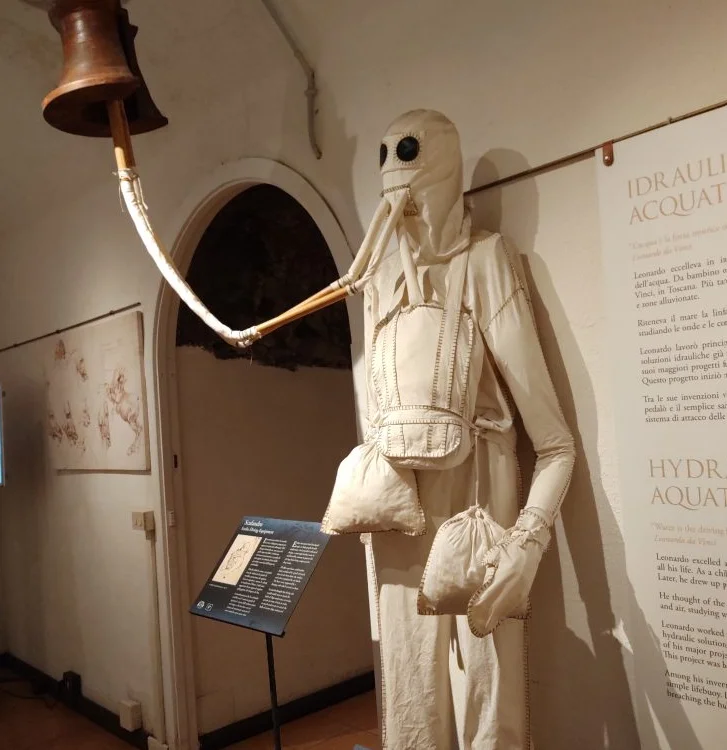
Leonardo da Vinci scuba gear
The diving suit with breathing tubes is one of Leonardo da Vinci’s most interesting ideas. This design shows his curiosity for exploring underwater environments and solving real-world problems.
The suit features long tubes that connect the diver to the surface, allowing air to reach the person underwater. Da Vinci imagined this invention for military use, believing Italian soldiers could use it to approach enemy ships secretly.
The suit was never built during his lifetime, but his sketches demonstrated that he understood the basic principles of scuba gear. His detailed drawings display a mix of observation, experimentation, and creativity.
These early designs inspired later inventors. Da Vinci’s diving suit remains a testament to technology ahead of its time.
11. Water lifting device (Archimedes’ screw)
The water lifting device uses a spiral-shaped screw to move water from a low place to a higher one. The concept dates back to ancient Greece, but Leonardo da Vinci created his improved designs and sketches of this machine.
Leonardo studied how the Archimedes’ screw worked. He made detailed drawings in his scientific notebooks.
He explored using different materials and shapes to enhance its performance for tasks such as irrigation and supplying water to buildings. His work with water lifting devices shows his curiosity about hydraulic machines and engineering.
These drawings demonstrate his skills as both an engineer and an inventor. Leonardo’s studies on water movement influenced later developments in hydraulic technology.
12. First gearbox design
Leonardo da Vinci created the first known sketches of a gearbox design during the Renaissance. In these detailed drawings, he demonstrated how gears could transfer and change motion, a capability that would become crucial for future machines and vehicles.
He imagined complex systems of interlocking gears long before modern engines were built. The gearbox ideas in his notebooks reveal how he combined scientific experimentation with creativity.
Leonardo’s fascination with clockwork mechanisms and problem-solving pushed him to design technology ahead of his time. Although many of these inventions stayed as prototypes or ideas, his engineering marvels influenced the development of machines for centuries.
13. Double hull ship concept
The double hull ship concept stands out as a prime example of Leonardo da Vinci’s innovation during the Renaissance. This design featured two layers in a ship’s hull to protect against damage from attacks or accidents.
By adding an extra layer, the vessel became safer for its crew and cargo. Leonardo’s scientific notebooks reveal how he applied observation and problem-solving to naval engineering.
He suggested a second hull could act as a shield, limiting damage if the outer shell was breached. This idea helped inspire safer shipbuilding in later generations.
As an inventor and engineer, his double hull ship design shows his ability to think beyond his time. The sketches display his curiosity and understanding of mechanics that were unusual for his era.
14. Flying parachute
The flying parachute was one of Leonardo da Vinci’s most interesting inventions. His designs showed a pyramid-shaped parachute made from linen and wooden poles.
Leonardo, the artist and inventor, believed this device could let a person safely descend from great heights. He included careful notes and sketches for the parachute in his scientific notebooks.
The design differed from modern parachutes, but it showed his curiosity and innovation. Leonardo’s prototype had a sealed cloth to help slow the fall.
While his parachute was never built during the Renaissance, later experiments proved it could work.
15. Improved canal lock system
Leonardo da Vinci made significant advances in the canal system during the Renaissance. He studied old locks and noticed that boats would often get damaged or stuck.
His solution was a new canal lock design with double gates and better water flow control. With his engineering skills, Leonardo designed locks that made it safer for boats to travel between areas at different water levels.
His canal lock system helped protect boats and save time moving goods in cities like Milan and Florence. These engineering marvels showed his deep understanding of hydraulics and mechanics.
16. Solar power concentration mirrors
Solar power concentration mirrors were one of Leonardo da Vinci’s lesser-known innovations during the Renaissance. He imagined using large, curved mirrors to focus sunlight and generate heat.
As an engineer and inventor, Leonardo’s design aimed to heat water for possible industrial uses. His sketches reveal his advanced understanding of reflection and the power of focused light.
Today, engineers recognize these designs as early concepts for solar energy systems. Some historians believe his solar concept helped inspire later developments in solar power, as explained in detail by Business Insider.
17. Mechanical drum for infantry
The mechanical drum for infantry was one of Leonardo da Vinci’s fascinating war machines. Leonardo designed this device to help troops keep rhythm during marches or battles.
He incorporated gears and clockwork mechanisms into his sketches to automate the drum’s operation. His mechanical drum shows Leonardo’s interest in combining music with military technology.
He believed that coordinated drumming could improve an army’s discipline and timing. Da Vinci’s notebooks contain detailed drawings of this innovative device.
The design uses wheels and levers to strike the drum. Leonardo’s curiosity and creativity led him to experiment with many inventions that were ahead of his time.
18. Cam Hammer
Leonardo da Vinci’s cam hammer is a groundbreaking invention that used a rotating cam to lift and drop a hammer, automating the metalworking process and significantly improving efficiency during the Renaissance.
This innovative mechanism not only reduced manual labor but also laid the groundwork for future advancements in automated machinery, contributing to the Industrial Revolution.
Today, the cam hammer is celebrated for its blend of art, science, and engineering, and continues to inspire modern engineers and enthusiasts.
19. Ball bearing concept
The ball bearing concept stands out as one of Leonardo da Vinci’s clever engineering ideas. He tried to solve problems of friction in moving machines.
His drawings and sketches demonstrate how spheres can be placed between surfaces, enabling them to move more smoothly. Leonardo used his observations of mechanics and physics to guide his designs.
He may not have built working prototypes, but his scientific notebooks described how ball bearings could support heavy loads and reduce wear. This concept became important in later centuries.
Today, machines and vehicles often use ball bearings. His curiosity and focus on problem-solving helped shape technology hundreds of years after his time.
20. Self-propelled car design
Leonardo da Vinci designed a self-propelled cart in the late 15th century, which is considered a precursor to the modern automobile.
Powered by coiled springs and featuring gears, steering, and brakes, his innovative cart could move independently and showcased advanced mechanical engineering for its time.
Although never built during his lifetime, the design has been reconstructed and is recognized as a significant step toward autonomous vehicles.
Frequently Asked Questions
Leonardo da Vinci is known for inventing early flying machines, tanks, and creative devices far ahead of his time. He made significant advances in both art and engineering, creating renowned paintings, designing bridges, and exploring innovative methods to understand nature.
What was Leonardo da Vinci’s biggest invention?
Many people consider Leonardo’s ornithopter flying machine to be his most ambitious invention. He studied how birds fly and designed the machine, hoping humans could fly in the same way.
He never built the machine, but his detailed sketches show his dedication to understanding flight.
What is Leonardo da Vinci’s greatest achievements?
Leonardo’s greatest achievements include his paintings, such as the Mona Lisa and the Last Supper. He also made scientific discoveries in anatomy, engineering, and nature.
He created blueprints for inventions like the armored vehicle and early helicopters. Leonardo drew detailed anatomical drawings that blended art and science.
What are 4 things Leonardo da Vinci did?
Leonardo painted masterpieces, such as the Mona Lisa. He invented devices such as a self-supporting bridge and a parachute.
He studied the human body and made detailed anatomical sketches. He also designed an armored tank prototype during the Renaissance.
What are Leonardo da Vinci’s greatest works?
His most famous works are the paintings Mona Lisa and The Last Supper. His inventions include the ornithopter, the self-supporting bridge, and the armored tank.
He created scientific notebooks and anatomical drawings.
What was da Vinci’s IQ?
No official record exists of Leonardo’s IQ because modern tests did not exist during his lifetime. Experts believe he was brilliant based on his achievements in art, science, and invention.
Estimates sometimes suggest scores above 180, but these are only guesses.
Did Da Vinci invent the parachute?
Leonardo sketched an early parachute design. His drawing showed a pyramid-shaped frame covered in cloth.
Modern experiments have demonstrated that his parachute design is indeed effective.
What did Leonardo da Vinci do the most?
Leonardo spent much of his life drawing and painting. He filled many notebooks with sketches about anatomy, inventions, and nature.
He combined his interests in art, science, and technology in almost everything he did.
Did da Vinci invent the helicopter?
Leonardo designed the “helical air screw,” an early concept for a helicopter. It looks like a spinning screw made from linen and wire.
It could not fly, but his helical air screw design inspired later inventors.
Did da Vinci invent the submarine?
Leonardo drew early sketches for underwater breathing tools and a submarine. He never built a working submarine and kept some of his ideas secret because he worried about their potential use in war.
What was Leonardo da Vinci’s first robot?
Leonardo created sketches for a mechanical knight, sometimes referred to as “Leonardo’s robot,” in the late 1490s. The robot could perform simple movements, such as sitting or waving its arms.
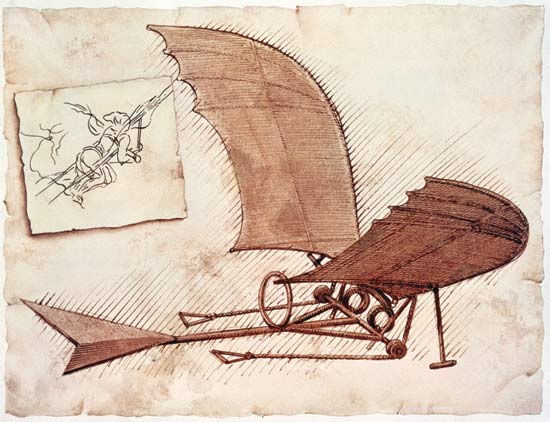

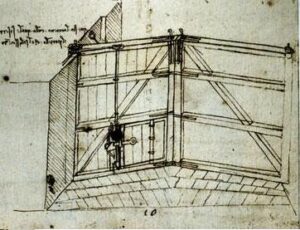
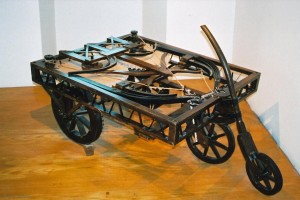
 I’m Leonardo Bianchi, the mind behind Leonardo da Vinci's Inventions. Thanks for visiting.
I’m Leonardo Bianchi, the mind behind Leonardo da Vinci's Inventions. Thanks for visiting. 
